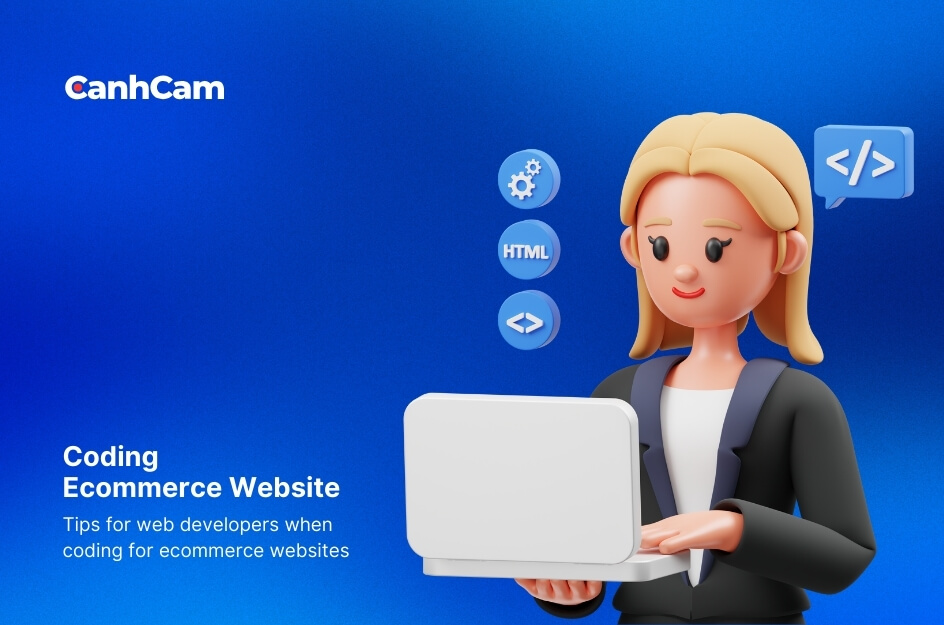This article Canhcam covers easy ways to code an ecommerce website:
- Using a website builder.
- Coding from Scratch.
- Step-By-Step Guide With CMS
We shall step-by-step process of making your ecommerce platform by using a Content Management System (CMS). With this approach, you have freedom, scalability, and efficiency, and it is easy to develop and maintain your web store. This guide provides all you need to know and understand to start the journey.
Choosing Your Platform for Coding an Ecommerce Website
Before you decide how to start building your ecommerce website there are two ways: website builder or coding from scratch.
Website Builder
Those looking for an easy and time-saving can build their e-commerce using a website builder. This method will be very easy for starters as well as those who do not understand programming.
Website builders use simple interfaces with built-in templates and drag-and-drop features that let users build and personalize their stores without advanced programming skills.
Plan for Beginners or Coding Experiences
It is common among website builders to use the user's limited or non-existent coding skills or technical expertise. These platforms enable users to work with user-friendly interfaces and simple tools that help in highly professional-looking websites.
Design your Webiste? Visit our Service: Business Web Design Melbourne
Offers Pre-built Templates and Drag-and-Drop
The availability of templates and drag-and-drop functionality are to be considered among the major benefits of the website builder. These templates are the starting point of building your ecommerce site and they provide you with several styles to choose from to match your brand look.
Furthermore, drag-and-drop features provide ease in customization, since the user is capable of editing elements such as text, images, and layouts without the need for coding.
Limited Customization Compared to Coding from Scratch
Although web-building tools ensure convenience and less work, they give fewer customizable elements than coding done from scratch.
Users may experience boundaries for the modification of certain design elements or the implementation of complex features that are not feasible for the templates and plugins in the platform.
Coding from Scratch
For those seeking excellent control over the design and functionality of their e-commerce website, coding from scratch provides the highest level of customization and flexibility.
This methodology entails creating the website from scratch by utilizing the mentioned programming languages including HTML, CSS, JavaScript, and PHP or Python.
Knowledge of HTML, CSS, JavaScript, and Server-side languages
Crafting a code requires a developer to refine their competency in several programming languages and technology. People must know the HTML language for page structure, CSS for style, and JavaScript for interactivity and must have server-side languages for handling dynamic content from databases.
Offers Complete Control Over Design and Functionality
The biggest plus with coding by hand is that you have the chance to have total control over the design and functioning of your website.
Developers have the power to adjust everything: from design and beauty to auxiliary processes and user experience to the most minute changes of the given elements.
More Time-consuming and Requires Technical Expertise
While writing your code is time-consuming and more technically demanding, it offers the option to customize and fine-tune every detail. Creating a highly customized ecommerce website involves boiling down to the core coding languages and thorough knowledge of web development concepts. Another challenge is that website development and upkeeping may cost a lot in terms of technical skills and resources.

Building With A Website Builder
The process of constructing an e-commerce website is a momentous one, which however necessitates meticulous planning and implementation for it to thrive. The foundation is an essential thing to begin with before getting into technical issues:
Pick a Platform and Plan
Begin by searching for and choosing a web developing tool that fits your e-commerce needs. Famous platforms like Shopify, Wix, and Squarespace all provide options designed to meet the requirements of online stores. Assess the pricing packages, features, and usability of every platform to find the one that perfectly fits your business.
Select a Domain Name
Choosing a domain name, which should represent your brand and be simple to remember. Make sure it describes your company or industry, guiding users to your online shop. Most website-building sites have domain registration services to make the process as compact as possible.
Choose a Template
Browse through the platform's library of pre-designed templates and choose one that fits your brand's look and the one that corresponds to your product categories.
Look for template themes that possess customizable features and a range of layouts in order not to compromise on flexibility in design.
Read more: What is C2B E commerce? Definition & Benefits
Figure out Your Sitemap
Plan the structure by drawing the site map, indicating the main navigation menu, product categories and additional pages as well, such as About Us, Contact, and FAQ. Organizing the content in a logical sequence will enhance user experience and make the site user-friendly.
Customize Your Website
Brand personalization is a vital component factor of your chosen template to be effectively used. Through the web-building tool, you can correct fonts, colours, images, and alignment to suit your styling. Include the same branding elements throughout the site such as logo, fonts, and layout to develop a community.
Set Up Ecommerce Options
Configure the e-commerce functions in the platform settings. Add product listings, which should have detailed descriptions, photos, and prices. Install payment gateways that permit customers to pay safely with different methods.
Determine shipping options, including pricing and delivery areas, while configuring tax systems that depend on your location and current code of regulations.
Preview and Test
Before the site is launched, all functions are tested with priority to give the best experience to users. Test checkout procedure involving adding items to the cart, applying discounts, and completing the payment process. Also, ensure that test responsiveness and compatibility with various devices and browsers are verified.
Go live
You can begin to attract customers once you are satisfied with the design and functionality of your ecommerce website. Double-check the all settings and configurations and then launch your website to the public. Track the performance metrics and customer feedback sensitivity to modify and improve online store performance.

Building From Scratch
Starting the process of designing an e-commerce website from scratch is not an easy task which requires a lot of planning, technical skills, and expertise:
Study up
Starting by learning the basics of HTML, CSS, JavaScript, and server-side languages like PHP or Python. These languages are the building blocks of web development and they play a vital role in the creation of dynamic and attractive websites.
Plan and Design the Website
Sketch wireframes and models to picture the arrangement, composition, and user journey on your website. This step assists in organizing your thoughts and developing a consistent approach to designing.
Write the Basic HTML
Start building your website by using HTML (Hypertext Markup Language) for its content and layout organization. HTML tags determine how a website is structured including headings, paragraphs, lists, and links.
Write the CSS Rules
Style your HTML components with CSS (Cascading Style Sheets) to define colours, typeface, spacing, and other visual attributes. CSS enables you to personalize the look of the website and make the pages visually pleasant too.
Incorporate JavaScript
Improve your website’s usability and user experience by implementing JavaScript into the site. JavaScript allows you to add interactive, animated, form validation and other dynamic elements to your website which makes it more interesting for the visitors.
Set Up a Server
Pick a reputable web hosting service provider and set-up your servers to run your website scripts and store data. Consider factors such as server reliability, scalability, and security when selecting a hosting provider to ensure optimal performance for your e-commerce store.
Purchase a Domain Name and Web Hosting
Once you have completed the development and testing stages, upload your website files to the web hosting server and start the e-commerce store.
Make sure it runs well and turn any minor bugs into a smooth user experience for your clients. With a will to succeed and a strong desire, your own-made e-commerce website will soon be serving your customers online effectively and efficiently.

Step-By-Step Guide With CMS
Choose your CMS
Make the first step by picking a CMS that will support a full-fledged e-commerce platform. Famous options like WooCommerce (works with WordPress), Magento, and Drupal Commerce are comprehensive solutions that can help all aspects of building and managing online stores. Consider factors such as ease of use, scalability, and available features when choosing the appropriate CMS for your e-commerce project.
Create an Account
Depending on the CMS you have chosen, you may need to register for a hosting account where your E-commerce site will be stored. Furthermore, some CMS systems incorporate hosting services as well, which makes the setup process as easy as ABC for the user. Select a hosting provider that offers excellent performance, a reliable security suite, and scalability to sustain the growth of your online store.
Select an Ecommerce Theme or Template
Pick an already existing e-commerce design theme or template that suits your brand identity and products. Many of the CMS platforms include different themes that were created with mobile responsiveness, adjustable layouts, and incorporated e-commerce functionalities in mind. Choose a theme that resonates with your target audience and provides a seamless user experience.
Customize Your Site and Build out Web Pages
Personalize the chosen theme to reflect your brand aesthetics and add more pages to provide the required functionality of your online store.
Customize design elements such as colors, fonts, and images to achieve a coherent brand experience. Create pages like About Us, Contact, and FAQ to show what your company is all about and what policies visitors need to be aware of.
Create Product Listings
Add products to your e-commerce website by creating detailed listings with product descriptions, images, prices, and categorizations.
Structure your products into appropriate main and sub-categories to allow easy browsing of the customers. Make sure your product listings are optimized for search engines to enhance visibility and attract your possible customers.
Set up a Payment Gateway, Inventory, and Tax Tools
Incorporate a secure payment gateway to accommodate online transactions and make available various ways of payment to buyers.
Through automation of inventory tracking and setting up notifications for items running low, inventory levels could be managed smartly.
Establish tax settings corresponding to your enterprise’s physical location and applicable regulations so that you can comply with the tax laws.
Preview and Publish your Online Store
Perform check-out testing, payment gateway integration, and responsiveness on mobile devices to troubleshoot and fix any existing problems. When you are convinced that your procedures run well, open your online store and attract customers to your items.
Find your Perfect Ecommerce Platform
Check a range of e-commerce platforms, hosting sites, and necessary factors to take into account when opening an online store. Contrast the features, plan pricing, scalability, and technical support offered by various platforms to make an ideal choice that matches your business needs. You can also research website builder tools and their E-commerce features to find out the best platform to launch the E-commerce project.
Though Final
Ecommerce website development involves a lot of responsibility in terms of technical competencies, budget and target objectives of the business.
To begin with, it involves ensuring a good customer experience with both aesthetics and functionality that are appealing to customers.
With the step-by-step guidance provided by CanhCam, you will gain the knowledge and tools you need to launch your ecommerce journey with confidence while at the same time developing your brand.

